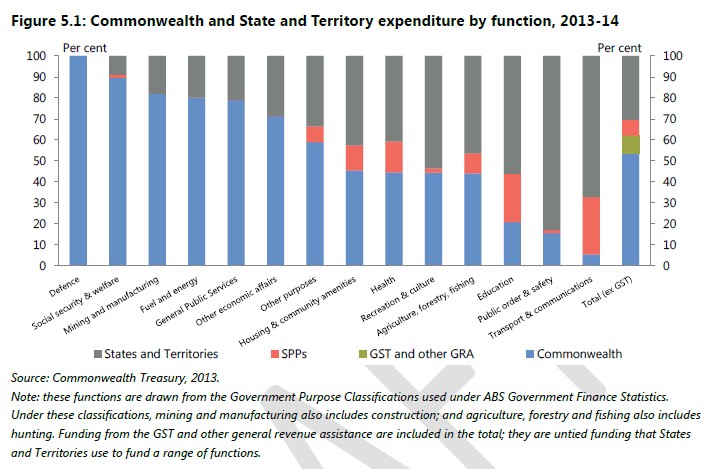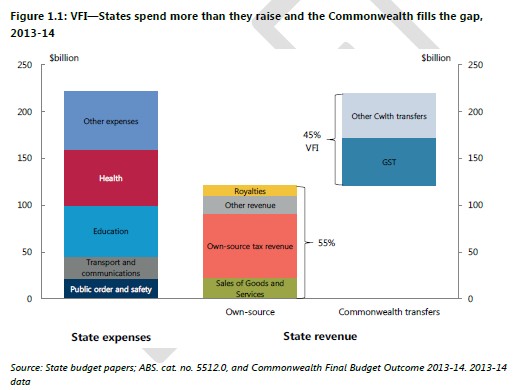With state premiers currently meeting with the Abbott Government in Canberra to discuss the federation, there is much speculation about whether an agreement can be struck on tax reform, health and education, to ensure that the federal system meets the needs of the population into the future.
While commentators often get hung-up on whether to raise the GST or other miniature, in my view, the over-riding key to successful outcomes rests on eliminating waste and duplication across the various levels of government, along with fixing the vertical fiscal imbalances (VFI) embedded in the current federal system.
On the issue of duplication, the Abbott Government’s 121-page discussion (green) paper on the reform of Australia’s federation, released last month, noted that there are multiple areas of shared responsibility for key policy areas (e.g. health and education) across the state and federal governments:

As the saying goes, “when everyone is responsible, no one is responsible”, and the shared responsibility between the commonwealth and states across many areas of public policy is creating sub-optimal outcomes for taxpayers and the nation at large, creating incentives for buck passing, cost shifting, and lack of accountability, not to mention the inefficient use of resources via excessive duplication between the various levels of government (e.g. state and federal health departments and agencies).
In theory, ending such duplication could deliver billions of dollars of benefits to taxpayers and the economy, by slashing costs as well as delivering more efficient and accountable outcomes.
In order to do so, however, VFIs – whereby the states’ responsibilities are well in excess of their revenue bases – must be reduced.
In this regard, the Abbott Government’s discussion paper also highlighted that the Commonwealth raises 82% of total tax revenue, the states and territories 15%, and local government just 3%.
The states and local governments, therefore, are left heavily reliant on Commonwealth funding, as illustrated in the next chart:

However, the discussion paper also warned that “there is no magic bullet to reduce or manage the level of VFI in Australia and any changes to revenue and expenditure responsibilities will involve trade-offs”.
Nevertheless, it did outline a number of options without committing to any particular one, including:
- Consolidating existing Commonwealth payments to the states into a single untied funding stream to be spent on areas such as hospitals and schools. This option would not reduce VFI, but would improve accountability and minimise the blame game.
- Increasing states’ access to tax revenue, for example by allowing states to raise their own income tax and/or expanding the GST.
- Shifting more responsibilities to the Commonwealth (e.g. healthcare).
Regardless of what reform option is chosen, without addressing VFIs, there can be no meaningful reforms to the federation. Rather, the state’s and feds will continue to pass the buck, cost-shift, and blame each other, leading to sub-optimal outcomes for Australian taxpayers.
Ultimately, a better functioning federation is about having clearly delineated responsibilities, along with revenue sources that are commensurate with their level of responsibility.

